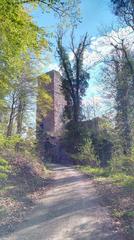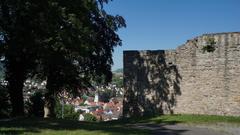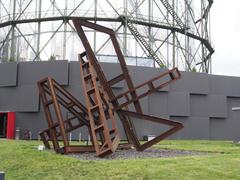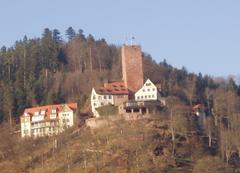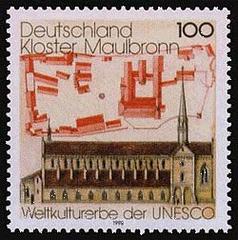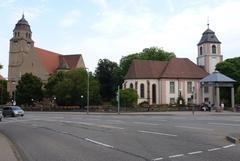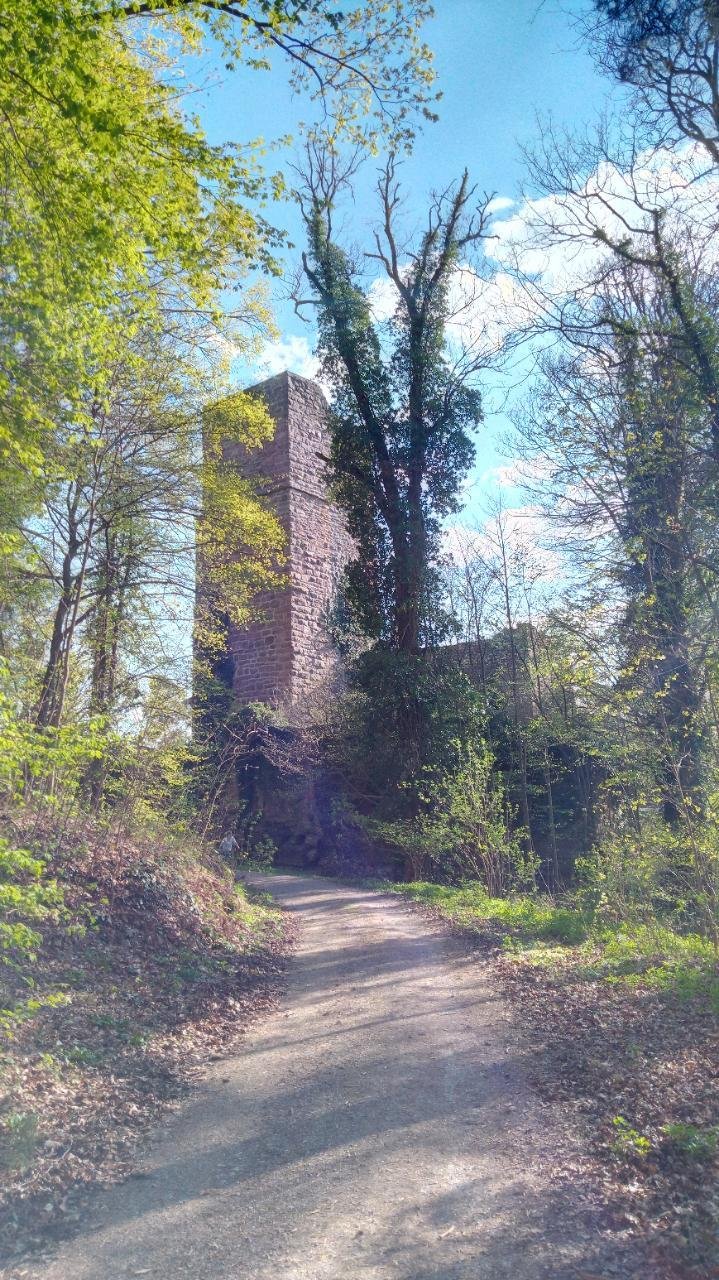
Comprehensive Guide to Visiting Burgruine Liebeneck, Pforzheim, Germany
Published Date: 01/08/2024
Introduction to Burgruine Liebeneck
Nestled near Pforzheim, Germany, Burgruine Liebeneck is a captivating medieval castle ruin that offers a rich tapestry of history dating back to the 12th century. This historical site, initially constructed around 1150 by the noble Counts of Eberstein, stands as a testament to the strategic military architectures and noble conflicts of medieval Germany (Burgenwelt). Visitors to Burgruine Liebeneck can explore its architectural remnants, which include a towering bergfried, defensive walls, and a central courtyard, all set against the picturesque backdrop of the Würm valley. This comprehensive guide will delve into the castle’s historical significance, visitor information, travel tips, and nearby attractions, making it an essential resource for history enthusiasts and casual travelers alike.
Table of Contents
Historical Background
Origins and Early History
Burgruine Liebeneck, located near Pforzheim, Germany, is a medieval castle ruin with a rich history dating back to the 12th century. The castle was initially constructed around 1150 by the noble family of the Counts of Eberstein. This period marked the height of castle-building in the region, driven by the need for fortified residences and strategic military outposts (Burgenwelt).
Architectural Evolution
The original structure of Burgruine Liebeneck was relatively modest, featuring a central keep, a surrounding defensive wall, and a few auxiliary buildings. Over the centuries, the castle underwent several expansions and renovations. By the 13th century, additional fortifications were added, including a larger curtain wall and more robust gatehouses. These enhancements were necessary to adapt to the evolving military technologies and the increasing threats from rival noble families and external invaders (Burgenarchiv).
Strategic Importance
Situated on a hill overlooking the Enz River, Burgruine Liebeneck held significant strategic importance. Its elevated position provided a commanding view of the surrounding landscape, making it an ideal location for monitoring and controlling the movement of goods and people along the river. The castle’s location also served as a defensive stronghold against potential invasions from neighboring territories (Pforzheim Tourism).
Ownership and Political Turmoil
Throughout its history, Burgruine Liebeneck changed hands multiple times, reflecting the turbulent political landscape of medieval Germany. In the late 13th century, the castle came under the control of the Margraves of Baden, a powerful noble family with extensive territorial holdings. The Margraves used the castle as a base for their military campaigns and as a symbol of their authority in the region (Landeskunde Baden-Württemberg).
During the 14th and 15th centuries, the castle was frequently involved in regional conflicts, including the feuds between the Margraves of Baden and the Counts of Württemberg. These conflicts often resulted in sieges and partial destructions of the castle, necessitating frequent repairs and reconstructions (Historisches Lexikon Bayerns).
Decline and Abandonment
The decline of Burgruine Liebeneck began in the late 16th century, as the political and military landscape of Europe underwent significant changes. The advent of gunpowder and artillery rendered many medieval castles obsolete, and Liebeneck was no exception. By the early 17th century, the castle was largely abandoned and fell into disrepair (Burgen und Schlösser).
Archaeological Discoveries
In the 19th and 20th centuries, Burgruine Liebeneck became the subject of archaeological interest. Excavations revealed numerous artifacts, including medieval pottery, weaponry, and architectural fragments, providing valuable insights into the daily life and defensive strategies of its inhabitants. These discoveries have helped historians piece together a more comprehensive understanding of the castle’s history and significance (Archäologie Online).
Preservation Efforts
Today, Burgruine Liebeneck is a protected historical site, managed by local heritage organizations and the city of Pforzheim. Efforts to preserve the ruins include stabilizing the remaining structures, preventing further decay, and making the site accessible to the public. These preservation efforts ensure that future generations can continue to explore and appreciate this remarkable piece of medieval history (Pforzheim City).
Cultural Significance
Burgruine Liebeneck holds a special place in the cultural heritage of the Pforzheim region. It serves as a tangible link to the past, offering visitors a glimpse into the medieval world of knights, nobles, and feudal conflicts. The castle is also a popular destination for educational tours, historical reenactments, and cultural events, helping to keep the history of the region alive and relevant (Kulturregion Karlsruhe).
Visitor Information
Visiting Hours and Tickets
Burgruine Liebeneck is open to visitors year-round. The visiting hours are from 9:00 AM to 6:00 PM daily. Admission to the site is free, but donations are encouraged to support preservation efforts (Tourismus Baden-Württemberg).
Guided Tours and Special Events
Guided tours are available upon request and offer a more in-depth exploration of the castle’s history and architecture. Special events, including historical reenactments and cultural festivals, are held throughout the year, providing unique opportunities to experience the castle’s past firsthand.
Travel Tips and Accessibility
The castle is easily accessible by car, with parking available near the entrance. For those using public transportation, a short bus ride from Pforzheim’s city center will bring you to the castle grounds. While the site is partially accessible for visitors with mobility issues, some areas may be challenging due to uneven terrain and stairs.
Nearby Attractions
Visitors to Burgruine Liebeneck can also explore other historical sites in the Pforzheim region, including the Pforzheim Jewelry Museum and the Enz Valley Cycle Path. These attractions offer a well-rounded experience of the area’s cultural and natural heritage.
Conclusion
In summary, Burgruine Liebeneck is a fascinating historical site with a rich and complex history. Its origins, architectural evolution, strategic importance, and eventual decline reflect the broader historical trends of medieval Germany. Today, the castle remains a valuable cultural and educational resource, offering visitors a unique window into the past. Be sure to check the visiting hours and plan your trip to experience this remarkable piece of medieval history.
FAQ
Q: What are the visiting hours for Burgruine Liebeneck? A: The castle is open daily from 9:00 AM to 6:00 PM.
Q: Is there an entrance fee to visit Burgruine Liebeneck? A: Admission is free, but donations are encouraged to support preservation efforts.
Q: Are guided tours available? A: Yes, guided tours are available upon request.
Q: How can I get to Burgruine Liebeneck? A: The castle is accessible by car and public transportation. Parking is available near the entrance.
Q: Are there any special events at Burgruine Liebeneck? A: Yes, special events such as historical reenactments and cultural festivals are held throughout the year.
Citations and Further Reading
- Burgenwelt. (n.d.). Burgruine Liebeneck. Retrieved from https://www.burgenwelt.org/deutschland/liebeneck/object.php
- Burgenarchiv. (n.d.). Liebeneck. Retrieved from https://www.burgenarchiv.de/burg_liebeneck_in_baden-wuerttemberg
- Pforzheim Tourism. (n.d.). Burgruine Liebeneck. Retrieved from https://www.pforzheim.de/tourismus/sehenswuerdigkeiten/burgruine-liebeneck.html
- Landeskunde Baden-Württemberg. (n.d.). Liebeneck. Retrieved from https://www.landeskunde-baden-wuerttemberg.de/liebeneck
- Historisches Lexikon Bayerns. (n.d.). Burgruine Liebeneck. Retrieved from https://www.historisches-lexikon-bayerns.de/Lexikon/Burgruine_Liebeneck
- Burgen und Schlösser. (n.d.). Burgruine Liebeneck. Retrieved from https://www.burgen-und-schloesser.net/baden-wuerttemberg/burgruine-liebeneck/
- Archäologie Online. (n.d.). Burgruine Liebeneck. Retrieved from https://www.archaeologie-online.de/links/archaeologische-ausgrabungen/burgruine-liebeneck-1234/
- Pforzheim City. (n.d.). Denkmalpflege: Burgruine Liebeneck. Retrieved from https://www.pforzheim.de/kultur/denkmalpflege/burgruine-liebeneck.html
- Kulturregion Karlsruhe. (n.d.). Burgruine Liebeneck. Retrieved from https://www.kulturregion-karlsruhe.de/burgruine-liebeneck
- Tourismus Baden-Württemberg. (n.d.). Burgruine Liebeneck. Retrieved from https://www.tourismus-bw.de/Media/Attraktionen/Burgruine-Liebeneck
